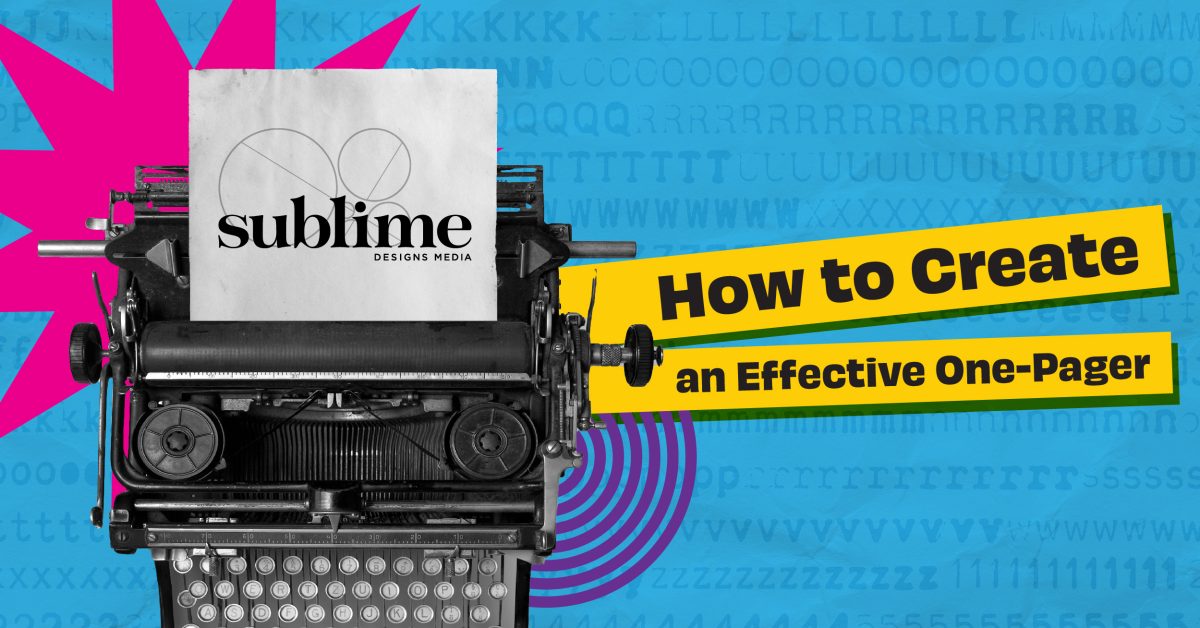I saw a meme the other day that said, “Hey, sorry I missed your text, I am processing a non-stop 24/7 onslaught of information with a brain designed to eat berries in a cave” and I’ve never felt quite so seen. It also gave me a good laugh.
We’ve talked a lot about how short people’s attention spans are these days, due to the deluge of information we’re all being presented with at every waking turn. Which is why using methods of concise (but informative) communication to cut through the noise is key.
Whether you’re pitching or showcasing a product or service, following up on a sales call, or attending an event and need a physical document that can summarize what your company does, a well-crafted one-pager can be the best tool in your arsenal. If done well, this single-page document will effectively distill crucial information in a way that’s easily digestible, visually appealing, and impactful.
A good, effective one-pager includes:
- A target audience: Before you dive into creating your one-pager, you should understand who your target audience is and what action you want them to take. This will focus your content and ensure it’s effective.
- Key information: Unlike longer forms of communication, a one-pager should include only the most pertinent information that aligns with your purpose. Is there a specific product or service you want to promote or is it a high level overview of your entire organization? What information does the reader need in order to make an informed choice without requiring a deep dive into complex materials?
- A good story: We’ve said it more than once, and we’ll say it again: everyone loves a good story. Once you have your necessary information, work to craft a story starting with a bold headline that alerts the reader of what they can expect in the details that follow. The headline will often speak to a problem the reader has that your product or service is solving.
- The value you’re providing: One of the first things your reader should see (and comprehend) is the value you’re providing. How are you making their lives better? Are you helping them save time? Money? Both? Be specific about what’s in it for them. This should be easy to do if you’ve done your homework about your audience. If they know this right off the bat they will be more inclined to continue reading.
- Differentiators: It’s a saturated market these days, no matter the market. Why should the reader buy your product or service versus someone else’s? Do you offer certain accelerators that help them move faster? Does your team specialize in a certain area of expertise? What sets you apart and makes you better than everyone else?
- Testimonials and/or logo bar: There’s a reason YELP exists. People want to know about the experiences of others before committing to something, especially when there are so many options out there. Customer quotes or testimonials for your work or product can quell the fears or indecision of the reader and lend credibility to what you’re selling. The same goes for a logo bar. Displaying the brands and companies you’ve worked with can speak volumes and can validate your product, service, and business.
- Thoughtful Design: Your one-pager should not only be clean, uncluttered, and on-brand, but it should also be organized and designed in a logical and visually appealing way. Use headings, subheadings, and bullet points to guide the reader’s eye and make sure the most critical information is prominently on display (like maybe that testimonial we mentioned above?). Additionally, the use of charts, graphs, icons, and images can help convey complex information quickly.
- A call-to-action (CTA): What is it that you want the reader to do once they’ve consumed the information you’ve presented? Whether it’s contacting you, signing up, visiting a website URL, or making a purchase, the CTA should be clear and straightforward.
- Contact information: This should go without saying, but always include contact information on your one-pager, whether it’s an email address, phone number, or website URL. You could even utilize a QR code, which is a great way to make follow-up information and action easily accessible, especially in today’s digital world.
The best thing about one-pagers is that they’re adaptable to a variety of contexts, from business proposals and marketing materials to project summaries and more. It also saves your readers time, which they are sure to appreciate, as it provides them with the essential information they need without requiring extensive reading or research.
Creating an effective one-pager requires a thoughtful approach to content selection, design, and audience engagement. If you need help creating one that captures attention and drives action, Sublime Designs Media is here to help. Just reach out at [email protected].
